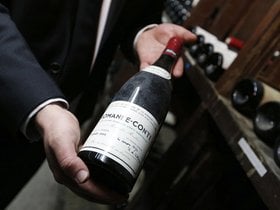Should You Invest in Wine ETFs? (What Are They + Alternatives)
Investing in a wine ETF may be a good way to diversify your portfolio and gain exposure to the lucrative fine wine market.
But how do you invest in wine ETFs?
And are they the best way to invest in wine?
We’ll answer all your burning questions about wine ETFs and how to invest in them, and suggest some options to add to your portfolio. From there, we’ll walk you through the other ways to invest in wine. (PS: One of the methods is both safe and profitable!).
Further reading
- Learn more about ETFs and similar options with this Guide to Liquid Alternative Investments — assets that can be bought and sold daily.
- Are you a non-accredited investor seeking lucrative opportunities? Explore the Best Alternative Investments for Non-Accredited Investors.
- Unsure where to start with wine investment? Here are the Best Type of Wines To Buy For Your Portfolio.
This Article Contains:
- What are ETFs?
- What Are Wine ETFs & How Can You Invest in Them?
- 3 More Ways to Invest in Wine (Including a Safe and High-Yield Option)
What are ETFs?
An ETF (Exchange-Traded Fund) is a security that tracks a basket of stocks, quite like a mutual fund. You can use an ETF screener tool (like the Morningstar ETF screener) to find and compare ETFs based on holdings, performance, and so on.
Now, they differ from mutual funds in a few ways:
- Unlike a mutual fund, ETFs can be traded during the trading day.
- ETFs are passively managed and track an index (e.g., the Dow Jones Sustainability Eurozone Index or the Nasdaq US Smart Food & Beverage Index). With no fund managers, they come with lower expense ratios than mutual funds.
- ETFs are more tax-efficient than mutual funds.
- They usually deliver no less than the benchmark index performance — unlike mutual funds, which may or may not perform as well.
What Are Wine ETFs & How Can You Invest in Them?
Well, the fact is that there are no ETFs that are specific to wine.
Instead, you can invest in an ETF which includes wine, like an alcohol ETF.
Here’s a look at what alcohol ETFs are:
Alcohol-related ETFs are funds with an “alcohol involvement”. Unlike socially responsible ETFs, their portfolio’s market cap is exposed to companies related to alcohol, such as producers, distributors, retailers, and licensors.
Here are a few ETFs with holdings in alcohol stocks, including beer, wine, and spirits stocks:
- Fidelity MSCI Consumer Staples Index ETF (NYSE: FSTA)
- Vanguard Consumer Staples ETF (NYSEARCA: VDC)
- AdvisorShares Vice ETF (NYSE: ACT)
- iShares Global Consumer Staples ETF (NYSE: KXI)
- Consumer Staples Select Sector SPDR Fund (NYSE: XLP)
Let's explore their performance in detail.
1. Fidelity MSCI Consumer Staples Index ETF (NYSE: FSTA)
The Fidelity MSCI Consumer Staples Index ETF offers investors exposure to US consumer staples companies, including those involved in the wine industry. Notably, it holds Constellation Brands (1.10%) and Brown Forman (0.34%), which are two major wine producers.
Historic Five-Year Performance Chart:
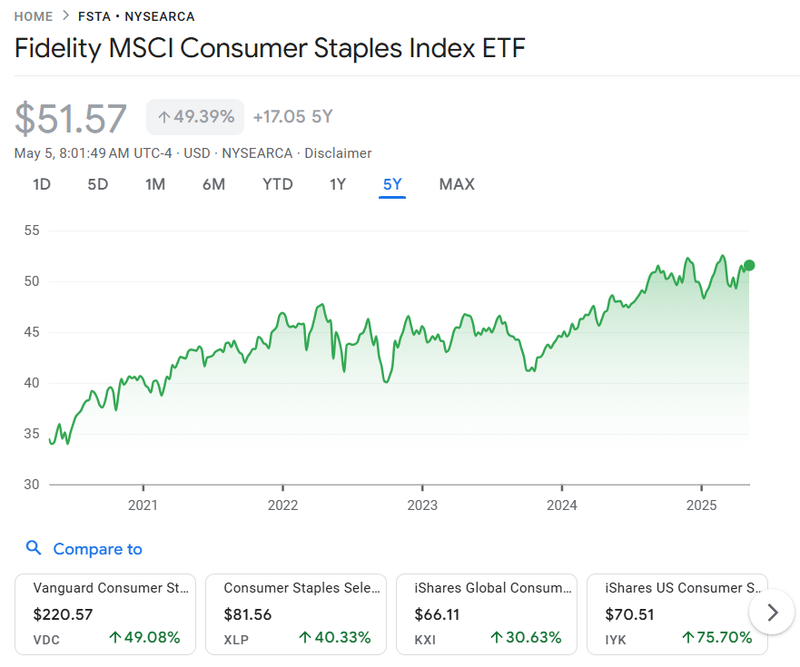
Source: Google Finance
- Key holdings: Costco Wholesale Corp (12.6%), Walmart Inc (12.12%), Constellation Brands (0.34%)
- Expense ratio: 0.08%
- PE Ratio: 24.84
- Annual Total Return Percentage: 13.30%
2. Vanguard Consumer Staples ETF (NYSEARCA: VDC)
The Vanguard Consumer Staples ETF invests in a wide range of US companies that produce household goods, food, and drinks (including alcoholic beverages). Its holdings feature wine producers like Constellation Brands and Brown Forman.
Historic Five-Year Performance Chart:
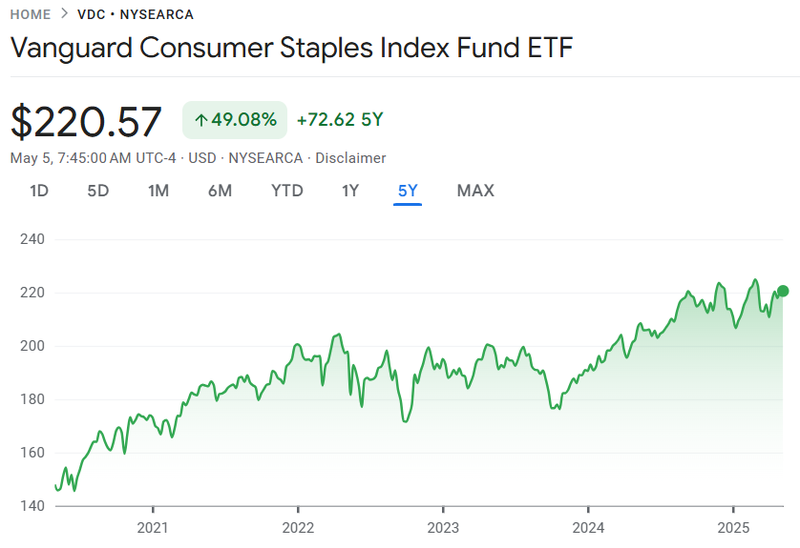
Source: Google Finance
- Key holdings: Costco Wholesale Corp. (12.16%), Constellation Brands (1.1%)
- Expense ratio: 0.09%
- PE Ratio: 24.33
- Annual Total Return Percentage: 13.32%
3. AdvisorShares Vice ETF (NYSE: ACT)
The AdvisorShares Vice ETF (NYSE: VICE) offers investors exposure to companies operating in industries often considered "vice" sectors, including alcohol, tobacco, and gaming.
The fund's holdings include Molson Coors Beverage Company (4.96%), which has significant involvement in the alcohol industry.
Historic Five-Year Performance Chart:
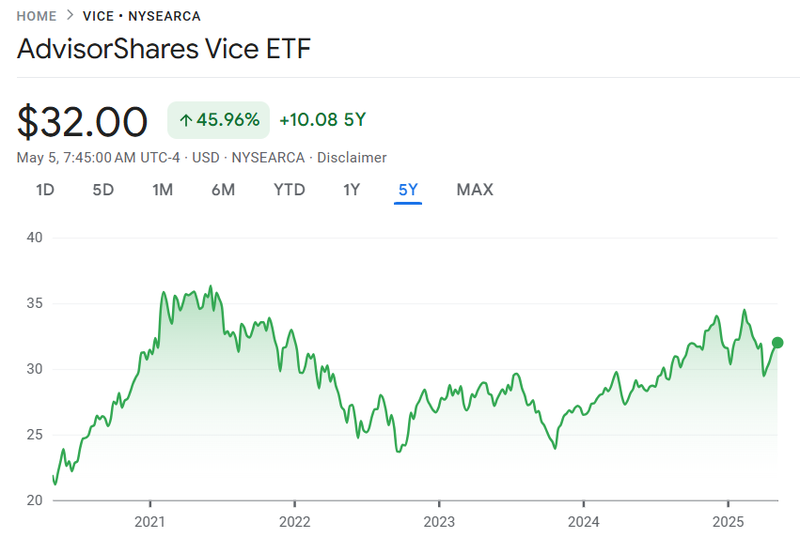
Source: Google Finance
- Key holdings: Philip Morris International (5.69%), Molson Coors Beverage Company (4.96%)
- Expense ratio: 0.99%
- PE Ratio: 15.34
- Annual Total Return Percentage: 18.27%
4. iShares Global Consumer Staples ETF (NYSE: KXI)
iShares Global Consumer Staples ETF offers investors diversified exposure to leading consumer staples companies worldwide. Notably, it includes prominent wine and spirits producers such as Diageo PLC (1.63%), Pernod Ricard SA (0.56%), and Constellation Brands Inc. (0.76%).
Historic Five-Year Performance Chart:
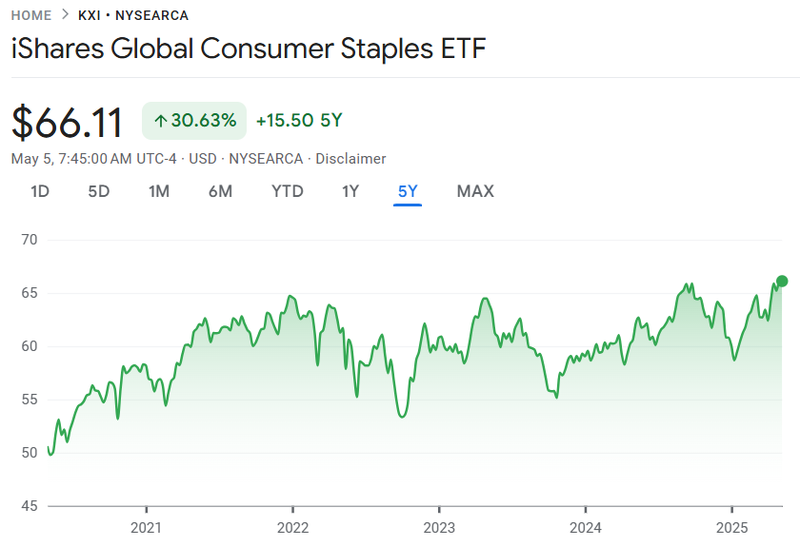
Source: Google Finance
- Key holdings: Costco Wholesale Corp (9.93%), Procter & Gamble (8.34%), Diageo PLC (1.63%)
- Expense ratio: 0.41%
- PE Ratio: 23.94
- Annual Total Return Percentage: 4.20%
5. Consumer Staples Select Sector SPDR Fund (NYSE: XLP)
Consumer Staples Select Sector SPDR Fund offers targeted exposure to the US consumer staples sector, encompassing industries such as food, alcoholic beverages, tobacco, and household products. Notably, it includes Constellation Brands Inc. (1.77%) and Brown-Forman Corporation (0.38%).
Historic Five-Year Performance Chart:

Source: Google Finance
- Key holdings: Costco Wholesale Corp (10.4%), Walmart Inc (10%), Constellation Brands (1.77%)
- Expense ratio: 0.08%
- PE Ratio: 22.77
- Annual Total Return Percentage: 12.19%
As we’ve mentioned, there’s no way to only invest in wine through a wine ETF. Instead, you’re investing broadly in the alcohol industry and several others.
But then there are a couple of alternatives you can try:
3 More Ways to Invest in Wine (Including a Safe and High-Yield Option)
Let’s face it — investing in wine ETFs can be a complex undertaking. Instead, you might want to consider investing in wine bottles, wine stocks, or wine funds.
Let’s start with the safest and most profitable option — investing in fine wine bottles through Vinovest.
1. Directly Invest In Wine Bottles With Vinovest
Vinovest is a wine investment company that lets you invest in sought-after wines that historically outperform the market.
How to Invest with Vinovest
You need to follow a simple five-step process:
- Sign up on the Vinovest website to become a wine investor.
- Complete a questionnaire to assess your risk tolerance and investment horizon.
- Check your customized wine investment portfolio.
- Fund your wine investor account with as little as $1,000.
- Track your wine investments portfolio in real-time.
Why Should You Use Vinovest?
Vinovest makes it easy to manage your wine investments.
The Vinovest team will buy vintages of investment-grade wine, store them, and sell them later at wine auctions or “members only” wine stock exchanges like the London International Vintners Exchange (Liv-Ex Fine Wine Market).
You could add incredible vintages of premier Bordeaux wines or bottles from Burgundy, Rhone Valley, or any other reputed wine region to your portfolio — all in just a few quick clicks.
Here are all the top reasons to invest through Vinovest:
- Trusted Buying & Selling: Vinovest traces the provenance and checks the authenticity of each wine bottle.
- Best Wine Prices: They source wines directly from wineries, global wine exchanges, and merchants at the best possible wholesale wine prices.
- Optimal Storage: The wine cases are stored in optimal conditions of humidity, temperature, air quality, light, and vibration with experienced storage providers.
- Tax Advantages: Vinovest has bonded warehouse facilities that charge no excise duty or VAT, passing on significant tax advantages to you.
- Low Fees: Vinovest charges a 2.85% annual fee (2.5% for an investment portfolio of over $50,000). This fee includes handling wine buying, wine fraud detection, storage, insurance, portfolio management, and wine selling.
- Full Insurance: Vinovest offers a full insurance policy at market value - almost like a Federal Deposit Insurance Corporation (FDIC) for your wines.
- Easy Selling: You can sell your wine portfolio at any time to a counterparty buyer and get the wines delivered to them.
What are the Benefits of Investing Through Vinovest Over ETFs?
Here are three key benefits of investing in wine through Vinovest vs. through ETFs:
- It provides a solid hedge against market volatility (unlike real estate or stock markets). Consider this: wine has outperformed the S&P 500 index by 1,000% over the last 20 years, including during downturns.
- You can invest solely in wine rather than a mix of commodities, which might not guarantee stable returns.
- You get full ownership over the wines you invest in.
Here’s a glimpse of the attractive returns you can potentially get through Vinovest:

2. Invest in Wine Stocks
If you have some risk tolerance, you can pursue traditional investments like stocks of the top publicly traded wine companies.
Here are five of them and their track record last year (2024):
| Market Cap | Net Income (Y/Y Change) | |
|---|---|---|
| Constellation Brands, Inc (NYSE: STZ) | 33.35 billion | -195.64% |
| Diageo PLC (NYSE: DEO) | 62.61 billion | -12.44% |
| Brown-Forman Corporation (NYSE: BF-B) | 16.31 billion | -5.26% |
| Willamette Valley Vineyards, Inc. (NASDAQ: WVVI) | 30.22 million | +308.67% |
| LVMH Moet Hennessy Louis Vuitton SE (EPA: MC) | $280.01 billion | -21.07% |
As you can see from these numbers, the stock market can be very volatile. All of these companies once boasted excellent market performance and have taken big knocks in recent years. This is due to political, economic, and social factors affecting supply and demand in the wine industry.
Some analysts predict a rebound in wine stock performance in 2025, but there’s no guarantee that your risk will pay off.
For more details about these wine stocks, check out this article.
3. Wine Funds
Wine funds are similar to private equity funds and are frequently recommended by financial advisors and institutional investors.
Why?
They are managed by knowledgeable institutional investors who can even identify and exploit arbitrage possibilities.
Here are a few examples:
- WineFortune Premium Selection LP Fund: Offers investments for as little as €1, aiming to generate an annual return of 13%. As of May 2025, the wine investment fund has reached 99% of the €750,000 investment needed for the current funding round.
- The Wine Capital Wine Fund: This investment fund, focusing on fine wine, is looking to hit a funding goal of $150 million with a five-year investment period.
- The InVino Fund: This investment fund allows shareholders to invest in sustainable vineyards and wine tourism in Portugal. It has a minimum investment period of eight years and a target internal rate of return of 7% per annum.
Remember that your investments in wine funds may be tied up for up to five or more years, and a redemption request will take weeks to process.
Furthermore, wine funds still have a track record of risk. Some notable wine funds in recent years (such as Nobles Crus) have come under scrutiny for problems with valuation, regulation, and misappropriation of funds.
Invest in Fine Wine Without the Hassle. Start With Vinovest.
Alcohol ETFs can be more resistant to market volatility than stock options because your investment is spread across several consumer industries. However, they’re not an ideal option if you want to really reap the benefits of investing in wine assets more directly.
Instead of trusting traditional investments and the stock market with your hard-earned money, you could invest in wine bottles as an asset.
And with Vinovest, a trusted online wine investment platform, investing in fine wine is easy and enjoyable.
We will buy, store, and sell your precious wine assets — from Bordeaux wines to Champagne. We can even ship your wine bottle to you to sip on if you want to enjoy the fruit of your investment. The stock market could never.
Sign up for free today if you want to invest in the finest investment-grade wines.

